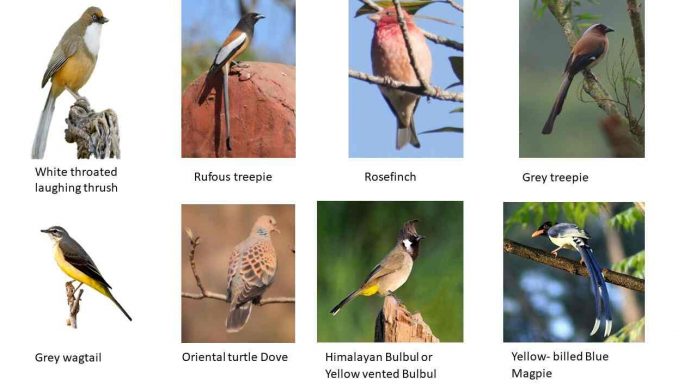Indian Birds: India is a textile form of art of landscapes that nourished the birdlife. Birds are the most beautiful and diversified creature in all the seven continents which belongs to well-defined vertebrate groups.
They belong to the Kingdom- Animalia, Phylum- Chordata, and Class- Aves which evolved from the reptiles and their connecting link is Archaeopteryx. They are characterised by various features like feathers, various beak shapes, oviparous (which lay eggs)- hard-shelled eggs, four-chambered hearts, warm-blooded in nature, and contain hollow bones or light feathers which help them to fly easily.
Types Of Indian Birds
They are of two types:
- Flight birds – which have a locking mechanism in their wings and
- Flightless birds – They do not contain this mechanism.
Classification of Indian birds
Classification of the birds depends on the area, according to scientists avian diversity is vast and each one of them created a checklist all over the world in a chronological manner. So many species of birds are common in various places in India but some are uncommon and are found only in a unique place.
Indian birds name along with their scientific names, habitat, diet, and conservation status
Here’s the completed table with Indian bird names and relevant details:
| Bird Name | Scientific Name | Habitat | Diet | Conservation Status |
|---|---|---|---|---|
| Peacock | Pavo cristatus | Forests, farmlands | Omnivorous | Least Concern |
| Indian Eagle | Aquila rapax | Grasslands, deserts | Carnivorous | Vulnerable |
| Indian Parrot | Psittacula krameri | Urban areas, forests | Herbivorous | Least Concern |
| House Sparrow | Passer domesticus | Urban areas | Omnivorous | Least Concern |
| Great Hornbill | Buceros bicornis | Dense forests | Omnivorous | Near Threatened |
| Indian Cuckoo | Cuculus micropterus | Woodlands, forests | Insectivorous | Least Concern |
| Common Myna | Acridotheres tristis | Urban areas, rural areas | Omnivorous | Least Concern |
| Indian Roller | Coracias benghalensis | Open grasslands, forests | Insectivorous | Least Concern |
| Painted Stork | Mycteria leucocephala | Wetlands, marshes | Carnivorous | Near Threatened |
| Indian Pitta | Pitta brachyura | Deciduous forests | Insectivorous | Least Concern |
| Black Drongo | Dicrurus macrocercus | Open fields, forests | Insectivorous | Least Concern |
| Baya Weaver | Ploceus philippinus | Grasslands, farmlands | Granivorous | Least Concern |
| White-throated Kingfisher | Halcyon smyrnensis | Forests, riversides | Carnivorous | Least Concern |
| Crested Serpent Eagle | Spilornis cheela | Forests, grasslands | Carnivorous | Least Concern |
| Indian Robin | Saxicoloides fulicatus | Scrublands, urban areas | Insectivorous | Least Concern |
| Greater Flamingo | Phoenicopterus roseus | Wetlands, saline lakes | Omnivorous | Least Concern |
| Common Tailorbird | Orthotomus sutorius | Gardens, bushes | Insectivorous | Least Concern |
| Black Kite | Milvus migrans | Urban areas, open fields | Carnivorous | Least Concern |
| Bar-headed Goose | Anser indicus | Wetlands, lakes | Herbivorous | Least Concern |
| Indian Pond Heron | Ardeola grayii | Wetlands, marshes | Carnivorous | Least Concern |
| Alexandrine Parakeet | Psittacula eupatria | Forests, urban areas | Herbivorous | Near Threatened |
| White-browed Wagtail | Motacilla maderaspatensis | Riversides, wetlands | Insectivorous | Least Concern |
| Spotted Owlet | Athene brama | Open fields, urban areas | Carnivorous | Least Concern |
| Green Bee-eater | Merops orientalis | Open grasslands, farmlands | Insectivorous | Least Concern |
| Rock Pigeon | Columba livia | Urban areas, cliffs | Herbivorous | Least Concern |
| Jungle Babbler | Turdoides striata | Scrublands, forests | Omnivorous | Least Concern |
| Indian Grey Hornbill | Ocyceros birostris | Forests, urban areas | Omnivorous | Least Concern |
| Indian Bush Lark | Mirafra erythroptera | Grasslands, scrublands | Insectivorous | Least Concern |
| Cattle Egret | Bubulcus ibis | Wetlands, farmlands | Carnivorous | Least Concern |
| Black-necked Stork | Ephippiorhynchus asiaticus | Wetlands, marshes | Carnivorous | Near Threatened |
| Common Kingfisher | Alcedo atthis | Riversides, lakes | Carnivorous | Least Concern |
| Lesser Whistling Duck | Dendrocygna javanica | Wetlands, lakes | Herbivorous | Least Concern |
| Eurasian Spoonbill | Platalea leucorodia | Wetlands, lakes | Carnivorous | Least Concern |
| Indian Swallow | Hirundo rustica | Open fields, urban areas | Insectivorous | Least Concern |
| Indian Silverbill | Euodice malabarica | Grasslands, open fields | Granivorous | Least Concern |
| Common Pigeon | Columba livia | Urban areas, cliffs | Herbivorous | Least Concern |
| Black-crowned Night Heron | Nycticorax nycticorax | Wetlands, marshes | Carnivorous | Least Concern |
| Eurasian Collared Dove | Streptopelia decaocto | Urban areas, farmlands | Herbivorous | Least Concern |
| Indian Eagle Owl | Bubo bengalensis | Forests, open woodlands | Carnivorous | Least Concern |
| Indian Scops Owl | Otus bakkamoena | Forests, urban areas | Carnivorous | Least Concern |
| Indian Silverbill | Euodice malabarica | Grasslands, dry areas | Granivorous | Least Concern |
| Shikra | Accipiter badius | Urban areas, forests | Carnivorous | Least Concern |
| Indian Paradise Flycatcher | Terpsiphone paradisi | Forests, gardens | Insectivorous | Least Concern |
| Indian Robin | Saxicoloides fulicatus | Scrublands, urban areas | Insectivorous | Least Concern |
| Indian Spot-billed Duck | Anas poecilorhyncha | Wetlands, lakes | Omnivorous | Least Concern |
| Blue-throated Barbet | Psilopogon asiaticus | Forests, gardens | Omnivorous | Least Concern |
Some birds are described on the basis of their size, shape, color etc.:
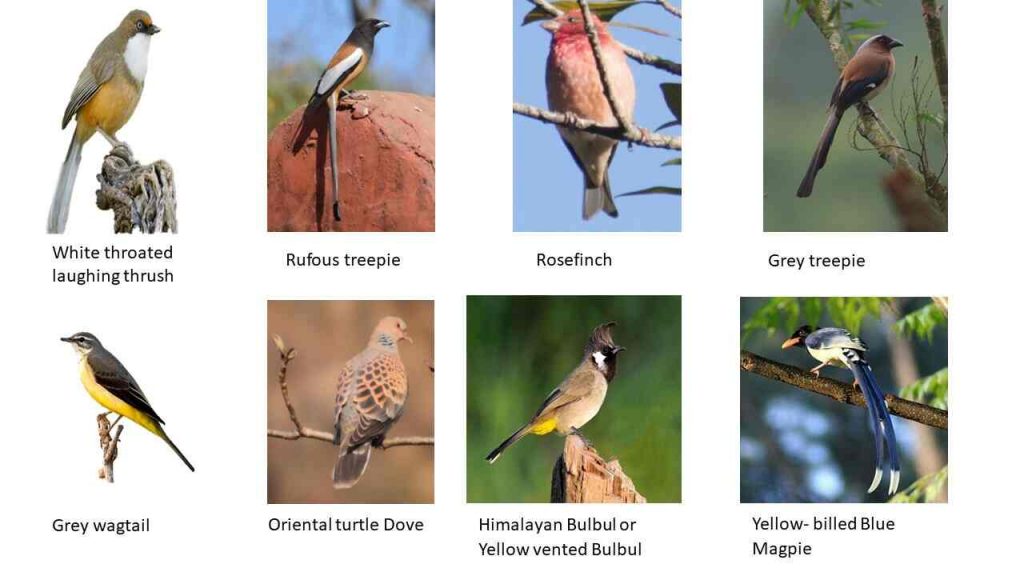
These are some bird pictures that are taken from the camera in the Himalayan region at the time of March or April. So these pictures show the diverse nature of their shape and size in their body, color patterns or beak shape and size, etc. Like the Yellow-vented Bulbul, we have a similar diversification in their species as Red-vented Bulbul which have the red vent; Dove has various varieties like the Oriental turtle Dove, spotted dove, etc., and great diversity contains magpies, treepie, etc.
Interesting Facts About Birds of India
1. Indian Roller: Known for its vibrant blue and purple feathers, the Indian Roller is often seen performing stunning aerial acrobatics during mating displays. It’s also the state bird of multiple Indian states, including Karnataka and Odisha.
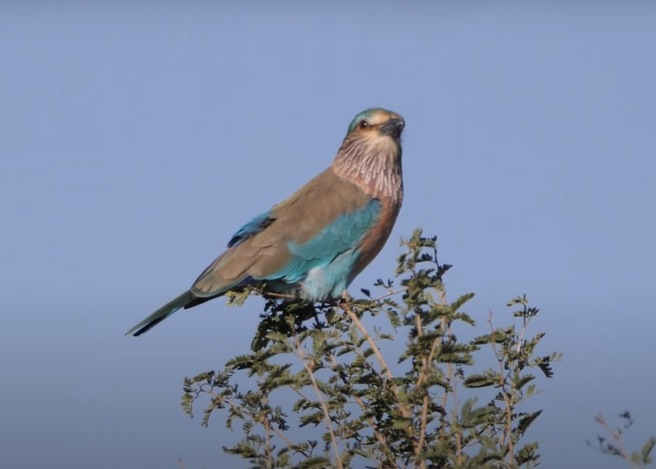
2. Painted Stork: This bird is distinguished by its colorful pink tertial feathers and yellow beak. They nest in large colonies, often with other species, and are commonly found near water bodies across India.
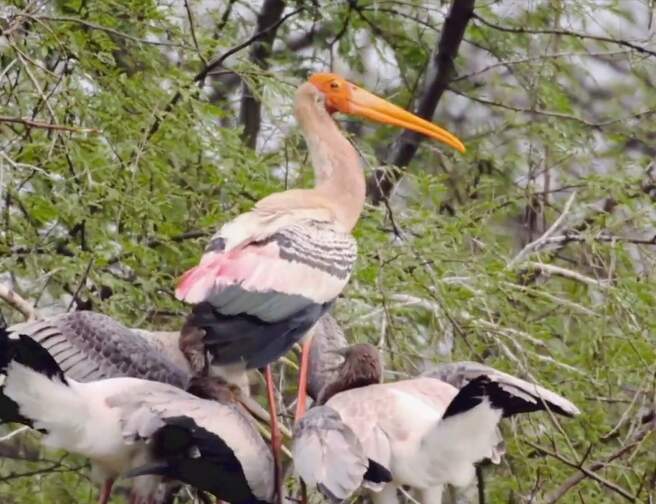
3. Greater Flamingo: Found in large numbers in Gujarat and Rajasthan, the Greater Flamingo gets its iconic pink color from the carotenoids in their diet of algae and crustaceans.
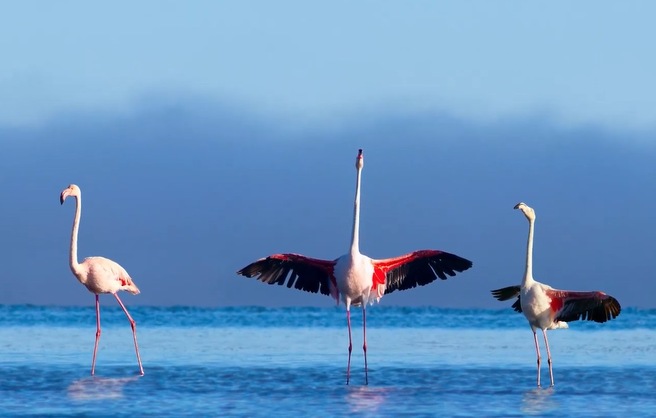
4. Sarus Crane: Standing at about 5 feet, the Sarus Crane is the world’s tallest flying bird. These elegant birds are known for their lifelong pair bonding and synchronized dancing rituals.
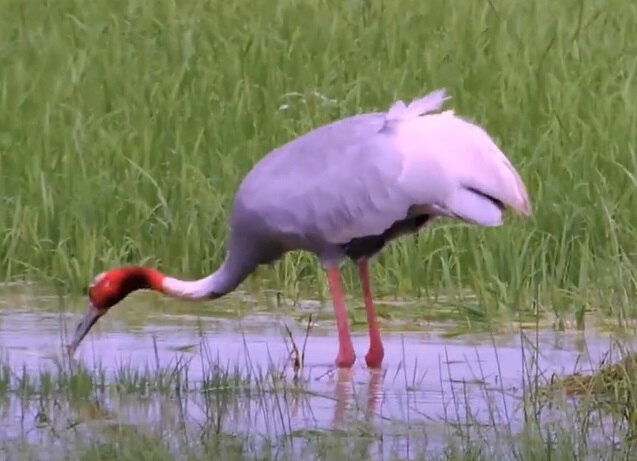
5. Indian Pitta: With its rainbow-like plumage of nine colors, the Indian Pitta is often referred to as the “Navarangi” in Hindi. It’s migratory and can be found in forested areas across the subcontinent.
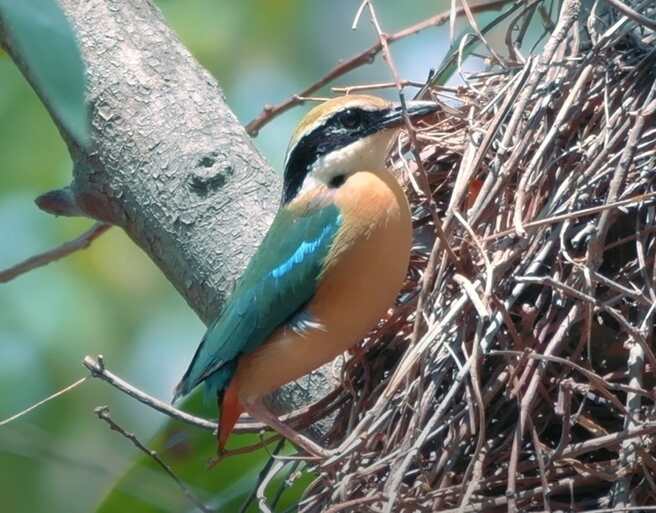
Bird Conservation Efforts in India
India is home to over 1,300 bird species, but the growing threats from habitat loss, climate change, and human activities have made conservation crucial. Organizations like the Bombay Natural History Society (BNHS) and the Wildlife Institute of India (WII) are actively involved in preserving bird habitats, raising awareness, and advocating for legislation. Projects such as “Save the Indian Vulture” and “The Great Indian Bustard Recovery Program” are focused on protecting endangered species.
Bird-Watching in India: Popular Destinations
India is home to numerous bird sanctuaries that attract bird-watchers from across the world. Here are a few notable ones:
| Place | Location | Establishment | Significance |
|---|---|---|---|
| Bharatpur Bird Sanctuary (Keoladeo Ghana National Park) | Bharatpur, Rajasthan | 1971 | A UNESCO World Heritage Site, home to over 370 species of birds, especially during winter migration. |
| Ranganathittu Bird Sanctuary | Karnataka | 1940 | Located near the Cauvery River, this sanctuary attracts migratory birds from Siberia and North America. |
| Chilika Lake Bird Sanctuary | Odisha | 1981 | Asia’s largest brackish water lagoon, a wintering ground for hundreds of species, including flamingos. |
| Kumarakom Bird Sanctuary | Kerala | 1980 | Nestled along Vembanad Lake, known for migratory species like Siberian cranes and waterfowl. |
| Vedanthangal Bird Sanctuary | Tamil Nadu | 1936 | One of the oldest bird sanctuaries in India, known for species like painted storks and pelicans. |
| Sultanpur Bird Sanctuary | Haryana | 1989 | Popular for bird-watching and is home to 250 bird species, particularly migratory waterfowl during winter. |
These destinations offer rich birding experiences, with many sanctuaries serving as vital stopovers for migratory birds from around the globe. Visitors can enjoy bird-watching in these peaceful natural reserves, especially during the migratory season (November to February).
Impact of Climate Change on Bird Migration
The changing climate has significantly impacted bird migration patterns in India. Traditionally, migratory birds such as the Siberian Cranes and Amur Falcons arrive during specific seasons, but erratic weather patterns have altered their arrival times. Some species have delayed migrations, while others have changed their routes or skipped migration altogether. This disrupts the balance of local ecosystems and raises concerns over long-term impacts on biodiversity.
Bird extinction is the major cause of degradation in the number of species through human interference. The main reason is habitat destruction, chemical contaminants through the developing projects or industries, etc. so we should do less pollution to save the flora and fauna. When some of the species reach the brink of extinction, some important measures have been taken to decrease the number.
What is Ornithology?
The study of birds is known as Ornithology which is done by Ornithologists as they are diversified in their body shape and size, color illustration, habitat, distribution on the local, regional, or continental scale, etc. Birds also have been studied or identified on the basis of their feeding habits, breeding, mating, courtship dance, or behavior.
The diversity of flora vegetation and fauna depends on latitude, longitude, and Climatic factors. For the wealth of bird’s abundance, they seek migration. Bird migration is the movement from one place to another according to seasonal or climatic influence. Where the temperature is too low there will be low bird diversity and where there is a moderate temperature, diversity will be high. Most of the bird species adapted or migrated the low land areas or lower altitudes for habitation because of the suitable temperature or the environment for example Blue-throated barbet, Great barbet, etc. were seen at the time of April but not in March at the same place. But some birds are native to their place and are found in the same place. Some are only found in the rainy season like the variety of Rose finches.
Methods to count the birds
There are various methods to count the birds like Random visualization or point counts and area searches and can be identified by their beak shape or size, colour distribution, body-streaked patterns, tail shape or size and their feeding habits, song, calls, Habitat whether they live domesticated, open areas or on the edges, etc. like the variety of tit birds have the short beaks; Drongo and magpie bird’s varieties have the long tail and feather features, etc.
Very valuable and important methods are applied for the bird’s identification. Some common birds can be identified or described very easily but this is not applied on all varieties.
When an unidentified bird is seen, draw a sketch or write their characteristics in the notebook, and click the picture in the camera. For the bird’s identification, we must take a field guide in which various varieties are given, match the characteristics and if two or three birds are of the same characteristics then see their distribution and also consult from the internet or the field guide. A field assistant can also be hired for the identification. Another method is to write their characteristics on Google and find a similar image of that species of bird and at last, see their geographical distribution and colour patterns of the body. Some field guides are preferred like Birds of the Indian Subcontinent (Ranjit Manakadan, J.C. Daniel & Nikhil Bhopale, 1886).
Indian birds species with voice descriptions, and interesting facts
| Bird Name | Scientific Name | Voice/Call | Other Information |
|---|---|---|---|
| Indian Peafowl / Peacock | Pavo cristatus | Loud, repetitive “mee-ow” | The national bird of India, males display feathers in courtship. |
| Rose-ringed Parakeet | Psittacula krameri | High-pitched screeching | Common pet, vibrant green color. |
| Great Hornbill | Buceros bicornis | Deep, resonant calls | Known for casque on beak, found in forests. |
| Asian Koel | Eudynamys scolopaceus | Distinct “ku-oo” | Often heard in early morning, parasitic bird. |
| House Sparrow | Passer domesticus | Chirping, chatter | Common in urban areas, small and social. |
| Indian Roller | Coracias benghalensis | Harsh calls | Noted for its vivid blue wings. |
| Common Hoopoe | Upupa epops | “hoo-hoo-hoo” calls | Known for its distinct crown of feathers. |
| Red-vented Bulbul | Pycnonotus cafer | Varied whistles and chirps | Found in gardens and forests, active singer. |
| Painted Stork | Mycteria leucocephala | Silent, occasional clattering | Large wading bird found near wetlands. |
| Indian Cuckoo | Cuculus micropterus | Repeated “bo-ko bo-ko” | Migratory, associated with monsoon season. |
| Common Myna | Acridotheres tristis | Loud, clear whistles and chatter | Often found in human settlements, opportunistic feeder. |
| Baya Weaver | Ploceus philippinus | Continuous chirping | Known for intricate nest weaving. |
| Black Drongo | Dicrurus macrocercus | Sharp, aggressive calls | Small, aggressive bird, protects its territory. |
| Indian Pitta | Pitta brachyura | Sharp two-note whistle | Colorful, ground-dwelling bird. |
| Brahminy Kite | Haliastur indus | High-pitched shrieks | Often seen near coasts and rivers. |
| Jungle Babbler | Turdoides striata | Harsh chattering | Known as “Seven Sisters” due to its social groups. |
| Greater Flamingo | Phoenicopterus roseus | Low honking sounds | Found in large flocks near wetlands and salt flats. |
| Black Kite | Milvus migrans | Shrill whistling | Scavenger bird, commonly seen circling in urban areas. |
| Indian Paradise Flycatcher | Terpsiphone paradisi | High-pitched trills | Strikingly long tail feathers in males. |
| White-throated Kingfisher | Halcyon smyrnensis | Loud, cackling calls | Found near water bodies, feeds on fish. |
| Cattle Egret | Bubulcus ibis | Soft, low croaking | Often seen near grazing cattle, feeds on insects. |
| Common Tailorbird | Orthotomus sutorius | Rapid, repetitive “chee-up” | Known for stitching leaves to build nests. |
| Indian Robin | Saxicoloides fulicatus | Melodic whistles | Found in scrublands and urban areas. |
| White-breasted Waterhen | Amaurornis phoenicurus | Loud, grating calls | Seen in marshy areas, recognizable by white face and breast. |
| Crested Serpent Eagle | Spilornis cheela | Shrill, high-pitched cries | Feeds mainly on snakes and other reptiles. |
| Bar-headed Goose | Anser indicus | Honking calls | Known for high-altitude migration over the Himalayas. |
| Spot-billed Pelican | Pelecanus philippensis | Silent, occasional grunting | Found in large water bodies, feeds on fish. |
| Indian Scops Owl | Otus bakkamoena | Soft, mellow hoots | Small owl found in forests and urban areas. |
| Eurasian Collared Dove | Streptopelia decaocto | Cooing “coo-coo-coo” | Often seen in rural and urban gardens. |
| Lesser Whistling Duck | Dendrocygna javanica | Soft whistling calls | Common in wetlands and paddy fields. |
| Rufous Treepie | Dendrocitta vagabunda | Harsh, grating calls | Related to the crow family, known for its boldness. |
| Grey Francolin | Francolinus pondicerianus | Repeated “ka-tee-turrr” calls | Ground-dwelling bird often found in dry scrublands. |
| Common Kingfisher | Alcedo atthis | Shrill, high-pitched whistles | Found near freshwater bodies, bright blue and orange plumage. |
| Alexandrine Parakeet | Psittacula eupatria | Loud screeching calls | Large parakeet with a green body and maroon shoulder patches. |
| White-browed Wagtail | Motacilla maderaspatensis | High-pitched chirps | Often seen near water bodies, wags its tail continuously. |
| Indian Bush Lark | Mirafra erythroptera | Melodic whistles | Found in grasslands, known for its aerial display. |
| Black-headed Ibis | Threskiornis melanocephalus | Silent, occasional croaking | Found in wetlands, easily recognizable by its black head and neck. |
| Brown Fish Owl | Ketupa zeylonensis | Deep, booming hoots | Found near water bodies, preys on fish and small mammals. |
| Indian Grey Hornbill | Ocyceros birostris | Loud, cackling calls | Found in forests and urban areas, known for its casque on the beak. |
| Indian Swallow | Hirundo rustica | Soft, melodic twittering | Found in open country, often nests in human structures. |
| Little Cormorant | Microcarbo niger | Grating, croaking calls | Common in wetlands, feeds on fish. |
| Spotted Owlet | Athene brama | High-pitched screeching | Small, nocturnal bird often seen in urban areas. |
| Eurasian Spoonbill | Platalea leucorodia | Silent | Large, white bird with a distinctive spoon-shaped bill. |
| Indian Pond Heron | Ardeola grayii | Harsh croaks | Common near freshwater bodies, often seen hunting fish. |
| Indian Silverbill | Euodice malabarica | Soft, twittering calls | Small, gregarious bird found in grasslands and open areas. |
| Shikra | Accipiter badius | Shrill “kee-kee” calls | Small bird of prey, commonly found in forests and urban areas. |
| Blue-throated Barbet | Psilopogon asiaticus | Resonant, repetitive “kutroo-kutroo” | Colorful bird found in forests, known for its bright blue throat. |
| Rock Pigeon | Columba livia | Soft cooing | Common in urban areas, a symbol of peace in various cultures. |
| Green Bee-eater | Merops orientalis | Soft trill | Known for catching bees and other insects mid-flight. |
| Black-necked Stork | Ephippiorhynchus asiaticus | Grunting and hissing | Large stork found in wetlands, known for its striking black and white plumage. |
| Indian Parakeet | Psittacula eupatria | Loud screeching calls | A large green parrot found in forests and urban areas. |
Hope this content helps you to find detailed information on Indian birds. Do let us know in case of you have any questions or suggestions for this topic. Feel free to put your comments below.
Also Read: World’s Most Beautiful Birds

